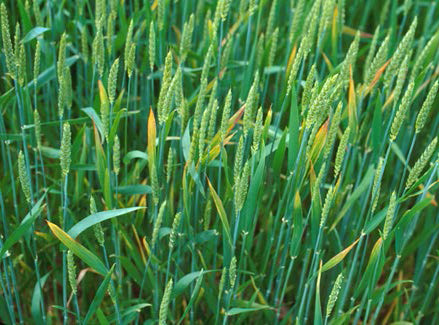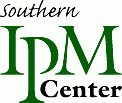Barley Yellow Dwarf Virus in Wheat
Barley Yellow Dwarf Virus
(cereal yellow dwarf, yellow dwarf, red lead)
Barley Yellow Dwarf Virus is reported to be the most widely distributed and most destructive virus disease of cereals.
Damage by BYDV varies with cultivar used, virus strain, time of infection, and environmental conditions. Infections are most widespead in the spring in areas where aphids overwinter; in winter wheat, autumn infections are most damaging.
Disease Symptoms
Primary symptoms of Barley Yellow Dwarf virus include plant stunting, reduced tillering, and yellowing and purpling

Barley yellow dwarf yellowing symptoms
of tips and margins of upper leaves. Leaf discoloration usually starts along the leaf margins and moves toward the leaf base and midrib.
Infected plants frequently occur in small, random groups which are evident as saucer-shaped depressions of yellow plants in otherwise green fields. Large portions of fields or entire fields can be affected in severe cases.
Virus-infected plants generally do not follow a row pattern. When affected plants do follow row patterns or appear to be associated with high or low areas of the field, look for environmental causes, nutritional problems or chemical injury. Symptoms generally take 2-4 weeks to develop, but at higher temperatures may not even develop. Definitive diagnosis of Barley Yellow Dwarf requires laboratory tests such as the ELISA (enzyme-linked immunosorbent assay) test.
Causative Agent
The Barley Yellow Dwarf virus is transmitted to wheat by several species of cereal aphids. The aphid vectors the disease from one plant to another. In Kentucky, the primary aphid transmitting BYDV is the oat bird-cherry aphid. Plant discoloration and stunting is evidence of transmission of the virus in the fall to seedling. Plant discoloration, but no stunting, is evidence of spring transmission of BYVD by the aphid vectors. Spring infections usually become evident anytime from flag leaf emergence through head emergence. Fall infections, on the other hand, are frequently noted as early as crop greenup in the spring. Serious yield loss is likely to occur where stunted and discolored plants are widely distributed in a field. Plants showing these symptoms may yield about 25 - 50% less than their non-stunted counterparts.
IPM Techniques
The best control for potential fall infections of BYVD is to avoid planting wheat before the Hessian fly-free date, mid October in Kentucky (avoid late-summer, early autumn seeding). Delayed planting will have little effect on spring infections. Plant wheat varieties with at least some tolerance or resistance to BYDV. Highly resistant or tolerant varieties are not yet available. Insecticide treatments aimed at controlling the aphids which transmit BYVD are inconsistent and unpredictable, and are often not recommended. Aphidicide treatments made to wheat already showing symptoms of BYDV will be of no value.
References and Additional Information
- IPM-4 Kentucky IPM Manual for Small Grains
- PPFS-AG-SG-3 Barley Yellow Dwarf by Don Hershman and Paul Bachi
- PPA-10c Kentucky Plan Disease Management Guide for Small Grains by D.E. Hershman and Paul Vincelli
- Annual Kentucky Small Grain Variety Trial, Progress Report 355
- Compendium of Wheat Diseases, M.V. Wiese (The American Phytopathological Society Press,1987)
- ENTFACT 121 - Aphids and Barley Yellow Dwarf on Kentucky Grown Wheat


